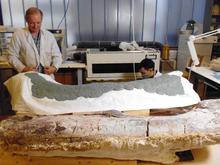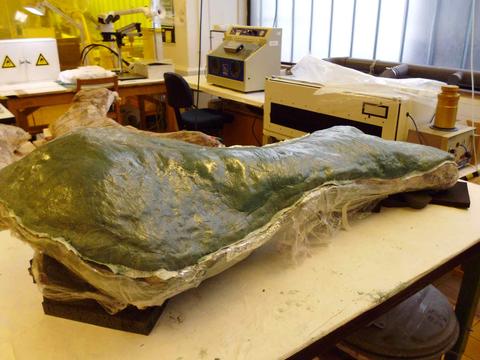Continuing on where we left off last time, this post will attempt to cover how we make a protective support jacket for very large or heavy specimens.
For really weighty specimens, like our dinosaur’s limb bones, we create a sort of supportive shell for the bone from a substance called Epopast, an epoxy resin/glass fibre paste. Epopast is pretty nasty stuff so to mix up a batch we need to get kitted out in full PPE (personal protective equipment)- goggles, mask, lab coat, apron, gloves and gauntlets (arm guards).
First things first, though- the bone must be protected before we go covering it with chemical goo. We cover the whole top surface with Clingfilm. The next step is important- any uneven areas where the Epopast might creep under must be filled out with plasticine, or the hardened jacket might be impossible to remove!
-

After carefully mixing the correct ratio of Epopast fibres with the goopy green hardener chemical, paying particular attention to the alarming hazard labels all over the containers, the mixture must be kneaded together vigorously to produce a doughy green pliable substance not unlike playdough and smelling faintly like biscuits. We take small handfuls of this stuff, shaping it into patties and applying them to the covered bone’s surface, gradually creating a layer over the whole top half of the specimen. Once the Epopast layer is in place, the finishing touch is to cover it over with another layer of Clingfilm (once patted down, this should ensure that no razor-sharp strands of hardened glassy resin are sticking up ready to stab unsuspecting fingers). Then we’ll leave it to harden for a few days. Once it’s fully set, we can then flip the bone over and begin the whole process again on the other side. Finally, the hardened Epopast jacket halves must also be smoothed down with an abrasive tool.
-

If all goes well, the bone ends up with a hard outer casing in two halves, like a shell, that can support its weight and protect it from damage.
-

…And that’s all I have to say at this stage about the Niger Sauropod! (By the way, if you caught the incomparable David Attenborough’s latest documentary, Natural History Museum Alive which was shown on New Year’s day, you’ll have seen the great man down here in the Conservation Centre and pointing out bits of the Niger Sauropod- before a CGI dinosaur hatchling sets about trying to undo all our hard work by running all over the bones!)
Stay tuned then to find out about what’s happening over at the conservation side of the lab, where zoology and botany specimens are restored, cleaned or readied for display in our galleries and exhibitions.
Kieran Miles involuntarily flinched when that CGI dinosaur jumped onto the sauropod femur we’d spent weeks preparing.

Comments
eIBfiNEfLvonfwy
Yes we are holding a firdnaisung event. We are still in the planning stages, but we are looking at it being on Jan. 5th. We will have info posted here in our website and on our Facebook page. Thank you
I want to download XRumer with discount !
Hello, my friends :)
I looking for XRumer with discount !!
Would you make advice me, where I can download it?
It is really the best program for mass posting on forums, blogs and social networks !..
P.S. I need XRumer of only latest version - 12.0.6, all other versions are too old and are not effective!
Add new comment